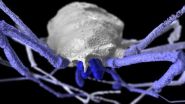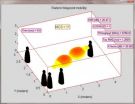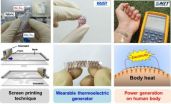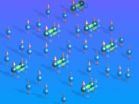(Press-News.org) Living harvestmen—a group of arachnids more commonly known as daddy longlegs—have a single pair of eyes that help them navigate habitats in every continent except Antarctica. But a newly described 305-million-year-old fossil found in eastern France shows that wasn't always the case. New research recently published in the journal Current Biology and led by scientists at the American Museum of Natural History and the University of Manchester indicates that primitive harvestmen had two pairs of eyes, adding significant details to the evolutionary story of this diverse and highly successful group.
"Terrestrial arthropods like harvestmen have a sparse fossil record because their exoskeletons don't preserve well," said Prashant Sharma, a postdoctoral researcher in the Museum's Division of Invertebrate Zoology and one of the lead authors on the new study. "As a result, some fundamental questions in the evolutionary history of these organisms remain unresolved. This exceptional fossil has given us a rare and detailed look at the anatomy of harvestmen that lived hundreds of millions of years ago."
Despite having eight long legs and being classified as arachnids, harvestmen are not spiders, even though they resemble them. Instead, they are more closely related to scorpions among the arachnids, a group that also includes mites and ticks. Arachnids can have two kinds of eyes: lateral, those on the side of the body; and median, those near the middle of the body. The former are lacking in harvestmen species living today.
But Hastocularis argus, the new species described by the researchers from the fossil, has both median and lateral eyes. The unique fossil's anatomy was studied in meticulous detail using high-resolution x-ray imaging at the Natural History Museum, London.
"Fossils preserved in three dimensions are quite rare," said Russell Garwood, a research fellow at the University of Manchester and a lead author on the study. "This is especially true of harvestmen. Our x-ray techniques have allowed us to reveal this fossil in more detail than we would have dreamed possible two decades ago."
The researchers corroborated their results by looking at the expression of a particular "eye-stalk-growing" gene in a living species of harvestmen. They found that developing embryos briefly express this gene in the lateral area, where the second eye pair is located in the fossil. But by the time they hatch, harvestmen only form the median eyes.
INFORMATION:
Other authors on the study include Jason Dunlop, from Humboldt University Berlin, and Gonzalo Giribet, from Harvard University, Cambridge. This collaborative work was partially supported by an 1851 Research Fellowship to Garwood and by the National Science Foundation under Grant No. DBI-1202751 to Sharma.
Four-eyed daddy longlegs fossil fills in evolutionary tree
305-million-year-old fossil indicates that primitive harvestmen had extra set of eyes
2014-04-10
ELSE PRESS RELEASES FROM THIS DATE:
New research on gigabit wireless communications
2014-04-10
Research on gigabit wireless communications has been presented by researchers from the University of Bristol at the world's leading wireless communications and networking conference, IEEE WCNC 2014, in Turkey earlier this week [Monday 6 to Wednesday 9 April].
The two research papers, led by Andrew Nix, Professor of Wireless Communication Systems and Dr Simon Armour, Senior Lecturer in Software Radio, from the University's Communication Systems and Networks research group in the Department of Electrical and Electronic Engineering, could have significant implications for ...
Thermoelectric generator on glass fabric for wearable electronic devices
2014-04-10
Wearable computers or devices have been hailed as the next generation of mobile electronic gadgets, from smart watches to smart glasses to smart pacemakers. For electronics to be worn by a user, they must be light, flexible, and equipped with a power source, which could be a portable, long-lasting battery or no battery at all but a generator. How to supply power in a stable and reliable manner is one of the most critical issues to commercialize wearable devices.
A team of KAIST researchers headed by Byung Jin Cho, a professor of electrical engineering, proposed a solution ...
Common sense health for young adult cancer survivors
2014-04-10
Many factors influence the life expectancy of childhood cancer survivors: not getting enough exercise, being underweight, and being worried about their future health or their health insurance. These are the findings of research led by Cheryl Cox of the St. Jude Children's Research Hospital in the US, published in Springer's Journal of Cancer Survivorship. The study found that, on average, childhood cancer survivors passed away before they were 40 years old.
Health-related behavior, self-perceived health status, and health concerns often influence mortality in the general ...
Iconic boreal bird species declining in the Adirondacks, study says
2014-04-10
A new study from the Wildlife Conservation Society finds that several iconic Adirondack birds are in trouble, with declines driven by the size of their wetland habitats, how connected these wetlands are to one another, and how near they are to human infrastructure.
The Adirondack Park represents the southern range extent for several species of boreal forest birds in eastern North America. Like any species at the edge of its range, they face challenges in this environment. The habitats of these boreal specialists – cool, wet, sphagnum-draped bogs and swampy woods – are ...
Uncovering a new angle on mental distance
2014-04-10
Why does the second hour of a journey seem shorter than the first? According to research from University of Toronto Scarborough (UTSC) and the Rotman School of Management, the answer lies in how we're physically oriented in space.
In a series of six studies, Sam Maglio, an assistant professor in UTSC's Department of Management, demonstrated that a person's orientation — the direction they are headed — changed how they thought of an object or event.
The research is forthcoming in Psychological Science, a journal of the Association for Psychological Science.
"Feeling ...
Sunlight generates hydrogen in new porous silicon
2014-04-10
Porous silicon manufactured in a bottom up procedure using solar energy can be used to generate hydrogen from water, according to a team of Penn State mechanical engineers, who also see applications for batteries, biosensors and optical electronics as outlets for this new material.
The surface area of this porous silicon is high," said Donghai Wang, assistant professor of mechanical engineering. "It is widely used and has a lot of applications."
The standard method for manufacturing porous silicon is a subtraction method, similar to making a sculpture.
"Silicon is ...
Extending terrorism insurance program could lower federal costs, study finds
2014-04-10
Federal spending after future terrorist attacks on the United States may be higher if the nation's terrorism risk insurance program is allowed to expire, according to a new RAND Corporation study.
The analysis finds that in a terrorist attack with losses up to $50 billion, the federal government would spend more helping to cover losses than if it had continued to support a national terrorism risk insurance program.
In the wake of the terrorist attacks of Sept. 11, 2001, terrorism risk insurance quickly became either unavailable or very expensive. Congress reacted by ...
Health of ecosystems on US golf courses better than predicted
2014-04-10
COLUMBIA, Mo. – Currently, there are more than 18,300 golf courses in the U.S. covering over 2.7 million acres. The ecological impacts of golf courses are not always straightforward with popular opinion suggesting that environmentally, golf courses have a negative impact on ecosystems. Now, researchers at the University of Missouri have determined that golf courses can offer a viable habitat for stream salamanders, and enhanced management practices may be beneficial to ecosystems within golf courses.
"If you look at the literature on golf courses, historically they get ...
Researchers bolster development of programmable quantum computers
2014-04-10
University of Chicago researchers and their colleagues at University College London have performed a proof-of-concept experiment that will aid the future development of programmable quantum computers.
Many complex problems are difficult and slow to solve using conventional computers, and over the last several years, research has grown steadily toward developing quantum computation. In particular, optimization problems such as the "traveling salesman" problem, which calculates the shortest possible route needed to visit a set of towns, become intractable as the number ...
MU researchers find rare fossilized embryos more than 500 million years old
2014-04-10
COLUMBIA, Mo. – The Cambrian Period is a time when most phyla of marine invertebrates first appeared in the fossil record. Also dubbed the "Cambrian explosion," fossilized records from this time provide glimpses into evolutionary biology when the world's ecosystems rapidly changed and diversified. Most fossils show the organisms' skeletal structure, which may or may not give researchers accurate pictures of these prehistoric organisms. Now, researchers at the University of Missouri have found rare, fossilized embryos they believe were undiscovered previously. Their methods ...
LAST 30 PRESS RELEASES:
Study reveals that the body uses different sensors to detect cold in the skin and in internal organs
iPS cells from dish to freezer and back
Deep neural networks enable accurate pricing of American options under stochastic volatility
Collective risk resonance in Chinese stock sectors uncovered through higher-order network analysis
Does CPU impact systemic risk contributions of Chinese sectors? Evidence from mixed frequency methods with asymmetric tail long memory
General intelligence framework to predict virus adaptation based on a genome language model
Antibiotic resistance is ancient, ecological, and deeply connected to human activity, new review shows
Vapes, pouches, heated tobacco, shisha, cigarettes: nicotine in all forms is toxic to the heart and blood vessels
From powder to planet: University of Modena engineers forge a low-carbon future for advanced metal manufacturing
Super strain-resistant superconductors
Pre-school health programme does not improve children’s diet or physical activity, prompting call for policy changes, study finds
Autumn clock change linked to reduction in certain health conditions
AI images of doctors can exaggerate and reinforce existing stereotypes
Where medicine meets melody – how lullabies help babies and parents in intensive care
We may never be able to tell if AI becomes conscious, argues philosopher
AI video translation shows promise but humans still hold the edge
Deep ocean earthquakes drive Southern Ocean’s massive phytoplankton blooms, study finds
Without campus leftovers to pick through, the beaks of this bird changed shape during the pandemic
High-dose antibiotic does not reduce mortality in tuberculous meningitis
How many insects fly in the sky above the USA?
Could cheese protect your brain health?
Who faces more difficulty recovering from stroke?
Colliding galaxies create the brightest, fastest growing black holes at their center
New BrainHealth research reveals tradeoffs on sleep with cannabis use for chronic pain
Aging-US now on ResearchGate, enhancing visibility for authors and readers
'Molecular glue' stabilizes protein that inhibits development of non-small cell lung cancer
Mount Sinai Health System is recognized in 2025 Chime Digital Health Most Wired survey
From prey to predator: How carnivores spread beneficial fungi
Menopause symptoms may be frequent and have negative effects, according to female endurance athletes
US Congressmembers’ responses on X to mass shooting events differ along party lines
[Press-News.org] Four-eyed daddy longlegs fossil fills in evolutionary tree305-million-year-old fossil indicates that primitive harvestmen had extra set of eyes







